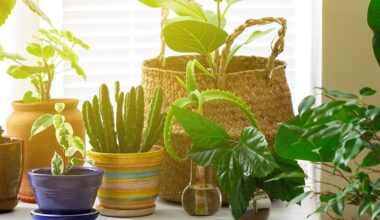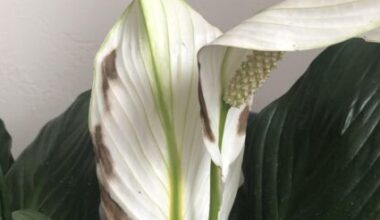Spending one’s life between four walls and enjoying daylight only through the glass of a window: the environment we impose on our house plants is not at all natural… So why should we be surprised to find them so feverish at the end of winter? Here’s why and how to get them out when the season is right.
Contents
Why taking indoor plants outside is good?
Even if you give them a sunny living environment indoors, it’s usually nothing compared to the brightness that plants can get outside! That’s why most plants will benefit from being outdoors – they will experience accelerated growth, improved appearance, healthier looking plants, etc. Rain and wind will clean them and often even allow them to bloom (which is not always the case indoors).
However, depending on your outdoor space, it is important to respect as much as possible the “natural” living environment of the plants, even outdoors. For example, a fern that prefers shade and humidity should not be placed in a place that receives strong sunshine all day long, and vice versa.
Which plants to take out? Which ones to keep inside?
Anthurium, Ficus, Dipladenia,… many plants cultivated inside can stay outside all summer long. Others, more fragile, do not support it. It is particularly the case of the plants of tropical origin (Bromeliaceae, many orchids, the Caladium, the Maranta, the Croton…) whose sensitive foliage requires regular fogging.
Similarly, if you cannot properly shelter your plants with downy foliage from the rain, leave them indoors.
Which location to choose?
Inside, even in bright situations, the amount of light received by green plants decreases sharply as their location moves away from openings (bay windows, windows …). While taking them out, it is necessary to avoid exposing them brutally to the direct sun rays, the risk being to observe very quickly burns or drying out!
A progressive adaptation to the open air is therefore necessary. It is a question of getting them accustomed little by little to bright light. To begin, install your green plants in a shady situation, then in mid-shade, under the cover of a tree, against a wall or at the foot of a hedge.
The succulents, as for them, support the full sun very well. Use a wheeled tray to move them more easily when they are grown in large pots.
Progressive exit
Place all the plants in mid-shade for one week. While most of these plants prefer subdued shade (under the bough of a tree, for example), some require full light, such as Cacti, succulents and some flowering plants.
For these plants, increase the light intensity little by little and place them in an open and airy place, but without drafts. Keep an eye on the leaves and reduce the brightness in case of a burn. Overheated locations against a wall are only suitable for Cacti. Increase the watering and adapt it to the various situations, as evaporation is more or less rapid.
When can the plants be taken out?
Wait until the risk of frost has been eliminated before taking houseplants out into the garden. Most are tropical species that do not tolerate any degree below zero. So be patient, and wait until June in areas where late frosts are common.
A period of transition
The golden rule for your indoor plants to fully benefit from their stay outdoors is to avoid abrupt changes. The transition from indoor to outdoor environment should be as smooth as possible. Do not place your plants in direct sunlight.
Instead, find a shady spot well sheltered from drafts and leave the plants there for at least ten days, the time it takes for them to adapt to their new habitat. It is very important to respect this acclimatization phase.
What maintenance should be planned?
In the evening, water the foliage of your green plants, on both sides, using a hand shower. Once a month, feed your plants with a special green plant fertilizer.
Clean them as often by removing yellowed leaves and damaged branches.
Remove your plants to check that their roots do not form a bun at the bottom of the pot. If this is the case, you will have to wait until early fall to repot.
When to bring them in again?
The plants should be brought indoors when the nights get colder and the days drop below 15 degrees. In the Montreal area where I am, it is usually around the end of September or early October. It’s very important to do this before frost, otherwise you risk losing your beautiful plants!
Before bringing them in, inspect them well for insects. Remove any that you can by hand (gloved, or with a garden hose) and use a natural homemade insecticide if necessary for a few days beforehand.
Once they are in, space them apart for a few weeks to prevent the spread of insects and continue to inspect them during this time.
When you bring them in, take the opportunity to cut off any damaged or wilted leaves, as well as wilted flowers, if applicable. Unlike spring, when the plants will go back and forth several times at first, in the fall, bring them in for good once and for all.
Summary
Plants with smooth foliage accustomed to humid atmospheres in the house generally like outside. They appreciate the regular showers offered by the rains which remind them of their country of origin and which rid them of certain parasites (such as whiteflies, red spiders…).
Group them together to facilitate care and watering during dry periods. Leave in them those that fear the wind (ferns with fine leaves like capillaries); rain (all downy foliage, gloxinia, saintpaulia, streptocarpus or put them on the edge of a protected window); large temperature differences (columneas, crotons). As for phalænopsis and benjaminas ficus, they do not like to be moved.









